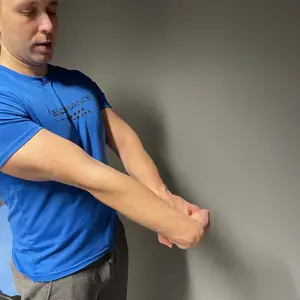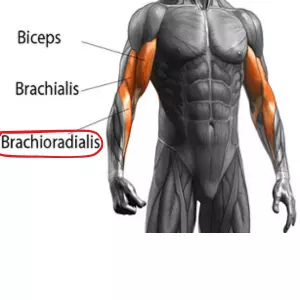Brachioradialis stretch: Best Stretches to Relieve Forearm Tightness
Brachioradialis stretches involve forearm and wrist movements to stretch the brachioradialis muscle.
These stretches can be performed standing or seated.
Let me show you the best way to stretch your brachioradialis muscle, function of this muscle and much more.
Stretching Exercises
Standing Brachioradialis Stretch
- Stand up straight with your shoulders relaxed.
- Extend your elbow on the arm you’re stretching brachioradialis muscle.
- Interlace your fingers, making your target arm on the top.
- Gently flex your wrist, making your fingers pointing downward.
- Then, point with your target arm fingers outward.
- You are using the opposite hand to stretch brachioradialis.
- Keep your elbow fully extended during this stretch.
- Hold this position for 30s.
Seated Brachioradialis Stretch
- Sit comfortably on a chair with your feet flat on the ground.
- Place your affected arm across your body, resting it on the opposite thigh.
- Ensure that your elbow is straight and your palm faces downwards.
- Use your opposite hand to gently press down on the back of the extended hand.
- Apply gentle pressure to deepen the stretch in the forearm.
- Hold this position for 30 seconds, feeling the stretch in your brachioradialis muscle.
Benefits of Brachioradialis Stretch
- Reduce muscle tightness in brachioradialis
- Maintaining brachioradialis flexibility can reduce the chances of a muscle strain injury.
- Improved range of motion during elbow flexion and forearm pronation, making your daily tasks that require precise arm and wrist movements easier.
- Stretching the brachioradialis muscle is particularly beneficial for those involved in activities or sports that exert the forarm muscles.
Anatomy and Function
The brachioradialis muscle originates from the lateral supracondylar ridge of the humerus, and inserts into the styloid process of the radius bone.
This muscle is easily identifiable due to its position on the radial side of the forearm.
Brachioradialis assists in elbow flexion, mostly when wrist is in a neutral position. (not supine or prone). Depending on the hand position, this muscle can help return the hand to a neutral position.
Brachioradialis stretching – extending the elbow and flexing the wrist with inward arm rotation has been shown to target bracioradialis muscle effectively.
Relevance
The Brachioradialis muscle is important when dealing with conditions like Wartenberg syndrome, a type of radial nerve neuropathy.
This muscle is also a key muscle in radial nerve post-injury, making its flexibility vital for rehabilitation.


